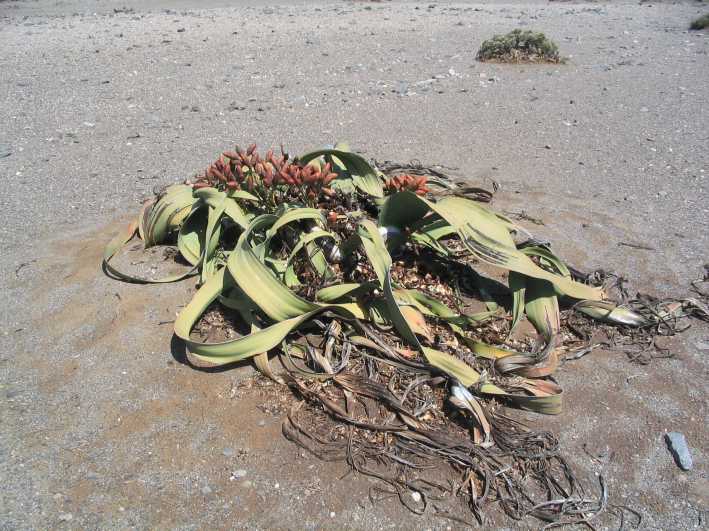- Gnetophyta
Taxobox
name = Gnetophyta

image_width = 240px
image_caption = "Welwitschia mirabilis "
regnum =Plant ae
divisio = Gnetophyta
classis = Gnetopsida
subdivision_ranks = Genera
subdivision =
*"Gnetum "
*"Welwitschia "
*"Ephedra"The
plant division Gnetophyta or gnetophytes comprise three related families ofwoody plant s grouped in thegymnosperm s. The gnetophytes differ from other gymnosperms in havingvessel element s as in theflowering plant s (Angiosperms or Magnoliophytes).The living Gnetophyta comprise three genera:
*"Gnetum "
*"Welwitschia "
*"Ephedra""
Gnetum " species are mostlywood y climbers in tropical forests. However, the most well-known member of this group, "Gnetum gnemon ", is a tree. Its seeds are used to produce a crispy "krupuk " snack known as "emping" or "krupuk belinjo"."
Welwitschia " comprises only one species, "Welwitschia mirabilis". It grows only in the deserts ofNamibia andAngola . The plant is strange in having only two large strap-like leaves for all its life. These grow continuously from the base, and are usually tattered at the ends by flapping in the winds.Plants of the genus "Ephedra" are known as jointfirs because they have long slender branches which bear tiny scale-like leaves at their nodes. "Ephedra" has been traditionally used as a
stimulant , but is acontrolled substance today in many jurisdictions because of the risk of harmful or even fatal overdosing.In some classifications all three genera are placed in a single order (Gnetales) but in others distributed among three orders, each containing a single family and genus.
"Gnetum" and "Welwitschia" diverged from each other more recently than from "Ephedra".cite journal | url = http://www.amjbot.org/cgi/content/full/91/10/1683 | title = Fossils and plant phylogeny | author = Peter R. Crane, Patrick Herendeen and Else Marie Friis | journal = American Journal of Botany | year = 2004 | volume = 91 | pages = 1683–1699 | doi = 10.3732/ajb.91.10.1683 ]
Knowledge of fossils of the gnetophytes has increased greatly since the 1980s. There are fossils from the
Permian , [cite journal | url = http://aob.oxfordjournals.org/cgi/content/full/94/2/281 | title = A New Permian Gnetalean Cone as Fossil Evidence for Supporting Current Molecular Phylogeny | author = Zi-Qiang Wang | journal = Annals of Botany | year = 2004 | volume = 94 | issue = 2 | pages = 281–288 | doi = 10.1093/aob/mch138 | pmid = 15229124 ] theTriassic , and theJurassic which may belong to the gnetophytes, but this is uncertain.cite journal | url = http://aob.oxfordjournals.org/cgi/content/full/98/1/123 | journal = Annals of Botany | year = 2006 | volume = 98 | issue = 1 | pages = 123–140 | doi = 10.1093/aob/mcl078 | title = Former Diversity of Ephedra (Gnetales): Evidence from Early Cretaceous Seeds from Portugal and North America | author = Catarina Rydin, Kaj Raunsgaard Pedersen, Peter R. Crane and Else Marie Friis | pmid = 16675607] The fossil record is richer starting in the earlyCretaceous , with fossils of plants as well asseed s andpollen which can be clearly assigned to the gnetophytes.Molecular phylogenies of extant gymnosperms have conflicted with morphological characters with regard to whether the gymnosperms as a whole (including gnetophytes) comprise a
monophyletic group or aparaphyletic one that gave rise to angiosperms. At issue is whether the Gnetophyta are thesister group ofangiosperms , or whether they are sister to, or nested within, other extant gymnosperms. Numerous fossil gymnosperm clades once existed that are morphologically at least as distinctive as the four livinggymnosperm groups, such asBennettitales , "Caytonia" and the glossopterids. When these gymnosperm fossils are considered the question of gnetophyte relationships to other seed plants becomes even more complicated.References
*Burleigh, J. G., and S. Mathews. 2004. Phylogenetic signal in nucleotide data from seed plants: implications for resolving the seed plant tree of life. "American Journal of Botany" 91: 1599-1613 ( [http://www.amjbot.org/cgi/content/abstract/91/10/1599 abstract] )
*Gifford, Ernest M., Adriance S. Foster. 1989. Morphology and Evolution of Vascular Plants. Third edition. WH Freeman and Company, New York.
*Hilton, Jason, and Richard M. Bateman. 2006. Pteridosperms are the backbone of seed-plant phylogeny. "Journal of the Torrey Botanical Society" 133: 119-168 ( [http://www.bioone.org/perlserv/?request=get-abstract&doi=10.3159%2F1095-5674(2006)133%5B119%3APATBOS%5D2.0.CO%3B2&ct=1 abstract] )
Wikimedia Foundation. 2010.
